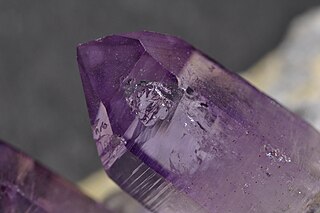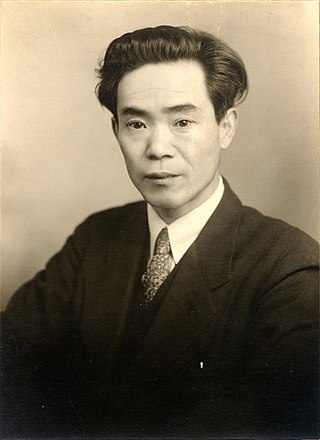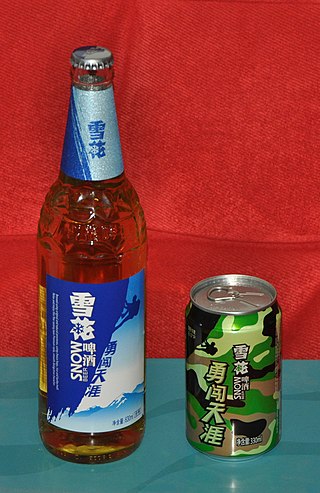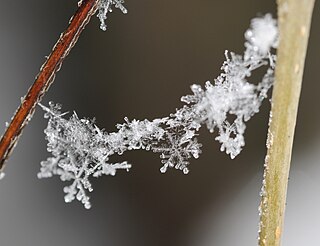
A crystal or crystalline solid is a solid material whose constituents are arranged in a highly ordered microscopic structure, forming a crystal lattice that extends in all directions. In addition, macroscopic single crystals are usually identifiable by their geometrical shape, consisting of flat faces with specific, characteristic orientations. The scientific study of crystals and crystal formation is known as crystallography. The process of crystal formation via mechanisms of crystal growth is called crystallization or solidification.

Snow comprises individual ice crystals that grow while suspended in the atmosphere—usually within clouds—and then fall, accumulating on the ground where they undergo further changes. It consists of frozen crystalline water throughout its life cycle, starting when, under suitable conditions, the ice crystals form in the atmosphere, increase to millimeter size, precipitate and accumulate on surfaces, then metamorphose in place, and ultimately melt, slide or sublimate away.

Diamond dust is a ground-level cloud composed of tiny ice crystals. This meteorological phenomenon is also referred to simply as ice crystals and is reported in the METAR code as IC. Diamond dust generally forms under otherwise clear or nearly clear skies, so it is sometimes referred to as clear-sky precipitation. Diamond dust is most commonly observed in Antarctica and the Arctic, but can occur anywhere with a temperature well below freezing. In the polar regions of Earth, diamond dust may persist for several days without interruption.

In meteorology, precipitation is any product of the condensation of atmospheric water vapor that falls from clouds due to gravitational pull. The main forms of precipitation include drizzle, rain, sleet, snow, ice pellets, graupel and hail. Precipitation occurs when a portion of the atmosphere becomes saturated with water vapor, so that the water condenses and "precipitates" or falls. Thus, fog and mist are not precipitation but colloids, because the water vapor does not condense sufficiently to precipitate. Two processes, possibly acting together, can lead to air becoming saturated: cooling the air or adding water vapor to the air. Precipitation forms as smaller droplets coalesce via collision with other rain drops or ice crystals within a cloud. Short, intense periods of rain in scattered locations are called showers.

Wilson Alwyn Bentley, also known as Snowflake Bentley, was an American meteorologist and photographer, who was the first known person to take detailed photographs of snowflakes and record their features. He perfected a process of catching flakes on black velvet in such a way that their images could be captured before they either melted or sublimated, and elaborated the theory that no two snowflakes are alike.

The International Glaciological Society (IGS) was founded in 1936 to provide a focus for individuals interested in glaciology, practical and scientific aspects of snow and ice. It was originally known as the "Association for the Study of Snow and Ice". The name was changed to the "British Glaciological Society" in 1945. With more and more non-British glaciologists attending its readings and submitting papers for publication, the name was changed to the "Glaciological Society" in 1962 and finally the Society acquired its present name in 1971. The IGS publishes the Journal of Glaciology, Annals of Glaciology and ICE, the news bulletin of the IGS; the Journal of Glaciology won the ALPSP/Charlesworth Award for the "Best Learned Journal of 2007".

An ice spike is an ice formation, often in the shape of an inverted icicle, that projects upwards from the surface of a body of frozen water. Ice spikes created by natural processes on the surface of small bodies of frozen water have been reported for many decades, although their occurrence is quite rare. A mechanism for their formation, now known as the Bally–Dorsey model, was proposed in the early 20th century but this was not tested in the laboratory for many years. In recent years a number of photographs of natural ice spikes have appeared on the Internet as well as methods of producing them artificially by freezing distilled water in domestic refrigerators or freezers. This has allowed a small number of scientists to test the hypothesis in a laboratory setting and, although the experiments appear to confirm the validity of the Bally–Dorsey model, they have raised further questions about how natural ice spikes form, and more work remains to be done before the phenomenon is fully understood. Natural ice spikes can grow into shapes other than a classic spike shape, and have been variously reported as ice candles, ice towers or ice vases as there is no standard nomenclature for these other forms. One particularly unusual form takes the shape of an inverted pyramid.

Hokuetsu Seppu is a late Edo-period encyclopedic work of human geography describing life in the Uonuma area of Japan's old Echigo Province, a place known for its long winters and deep snow.
The Kern arc is an extremely rare atmospheric optical phenomenon belonging to the family of ice crystal halos. It is a complete and faint circle around the zenith, in contrast to the related and much more common circumzenithal arc, which is only ever a partial circle.

Ukichiro Nakaya was a Japanese physicist and science essayist known for his work in glaciology and low-temperature sciences. He is credited with making the first artificial snowflakes.

Snow is a brand of lager beer from Shenyang, China. It is brewed by CR Snow, that was a joint venture between SABMiller and China Resources Enterprises. When Snow was first released in 1993 it was produced by three breweries. As of 2014, CRSB was the largest brewing company in China with over 90 breweries across the country, brewing more than 10 gigalitres of Snow every year.

Classifications of snow describe and categorize the attributes of snow-generating weather events, including the individual crystals both in the air and on the ground, and the deposited snow pack as it changes over time. Snow can be classified by describing the weather event that is producing it, the shape of its ice crystals or flakes, how it collects on the ground, and thereafter how it changes form and composition. Depending on the status of the snow in the air or on the ground, a different classification applies.

A snowflake is a single ice crystal that has achieved a sufficient size, and may have amalgamated with others, which falls through the Earth's atmosphere as snow. Each flake nucleates around a tiny particle in supersaturated air masses by attracting supercooled cloud water droplets, which freeze and accrete in crystal form. Complex shapes emerge as the flake moves through differing temperature and humidity zones in the atmosphere, such that individual snowflakes differ in detail from one another, but may be categorized in eight broad classifications and at least 80 individual variants. The main constituent shapes for ice crystals, from which combinations may occur, are needle, column, plate, and rime. Snow appears white in color despite being made of clear ice. This is due to diffuse reflection of the whole spectrum of light by the small crystal facets of the snowflakes.

"Setsugekka " / "Zan" is the thirty-sixth single of Japanese solo artist Gackt, released on December 9, 2009. Both sides are theme songs for the video game Samurai Warriors 3.

Fujiko Nakaya is a Japanese artist, a member of Experiments in Art and Technology, and a promoter, supporter, and practitioner of Japanese video art. She is best known for her fog sculptures.

The International Space Station is a platform for scientific research that requires one or more of the unusual conditions present in low Earth orbit. The primary fields of research include human research, space medicine, life sciences, physical sciences, astronomy and meteorology. The 2005 NASA Authorization Act designated the American segment of the International Space Station as a national laboratory with the goal of increasing the use of the ISS by other federal agencies and the private sector.
The Nakaya Islands are a small group of islands in Crystal Sound, about 18 km northeast of Cape Rey, Graham Land in Antarctica. They were named by United Kingdom Antarctic Place-Names Committee (UK-APC) after Ukichiro Nakaya (1900–62), a Japanese Professor of Physics from the University of Hokkaido, who specialized in the field of investigating the structure of ice crystals and snowflakes.
Cecilia Glaisher was an English amateur photographer, artist, illustrator and print-maker, working in the 1850s world of Victorian science and natural history.
OKEANOS was a proposed mission concept to Trojan asteroids, which share Jupiter's orbit, using a hybrid solar sail for propulsion; the sail was planned to be covered with thin solar panels to power an ion engine. In situ analysis of the collected samples would have been performed by either direct contact or using a lander carrying a high-resolution mass spectrometer. A sample-return to Earth was an option under study.

Snow science addresses how snow forms, its distribution, and processes affecting how snowpacks change over time. Scientists improve storm forecasting, study global snow cover and its effect on climate, glaciers, and water supplies around the world. The study includes physical properties of the material as it changes, bulk properties of in-place snow packs, and the aggregate properties of regions with snow cover. In doing so, they employ on-the-ground physical measurement techniques to establish ground truth and remote sensing techniques to develop understanding of snow-related processes over large areas.